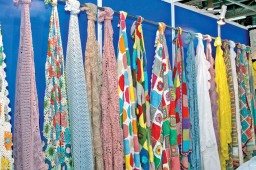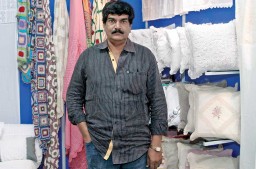
More than 1,00,000 home-based women artisans of about 100 villages in West Godavari, East Godavari and Krishna district of Andhra Pradesh and around 60 firms known for hand-made crochet laces, various products of home furnishing and even garments, are facing the heat of decreasing business despite various efforts and initiatives by the Government and other organizations to boost trade. Before recession, this hub was doing average business of Rs. 100 crore per annum but it has come down to even less than one-third, as now the figure is a mere Rs. 30 crore, the reasons are the usual ones – less demand, increasing cost, be it material or labour, more use of similar but machine-made products, lack of innovation in designing and marketing, poor skill development, less interest of next generation in this traditional work, etc. Apparel Online explores the efforts being made for the survival of this traditional technique…

There is so much adverse going on against the artisans of the Godavari hub that it has become difficult to find solutions. Among the most serious issues today is the lack of proper dyeing facility which is still being outsourced from Tirupur, Erode and even some parts of Delhi-NCR which not only adds cost but also increases the process time. Lack of expert technicians enhances the problem as Prakash of Godavari Delta Women Lace Artisans Co-operative Cottage Industrial Society Ltd., Narsapur, working directly with 10 buyers of various countries says, “Having a sustainable dyeing solution will help us a lot and as orders are increasing it is the need of the hour.” Associated with 1,000 women, the society claims to help the women in numerous ways, be it better rates than contractors, assurance of work availability throughout the year, support by organizing health camps and awareness meetings on various issues for their upliftment and even little training sessions about design inputs. In fact, design input is another big issue as the sector is an unorganized business, and intricate nature of production leaves little room for creativity and new designs as most of the women are not working for any particular firm; besides exporters too don’t take interest and are more concerned about getting their work done on time.

Many initiatives to support these women artisans have been taken by the Pan Godavari Lace Facilities and Services, Development Commissioner (Handicrafts) and Crochet Lace Park, an initiative by District Rural Development Agency, but they have not proved as fruitful as they could have. “Due to lack of funding in 2012-13 and in 2014 we were not able to take part in any international fair which is must for promotion and order booking,” says Kalavakolanu Tulasi, MD, Pan Godavari Lace Facilities and Services. Earlier, the group was participating in many reputed international fairs. Tulasi is hopeful that the upcoming common facility centre under cluster development scheme with a budget of Rs. 15 crore will be helpful in regards to dyeing and processing but he is not sure when it will start.
“In last three years business was not so good, but now it has started picking up. Germany used to buy a lot from the cluster a few years ago and it has now again started importing these products. Use of azo-free dyes and getting lab test done from audit agencies is also helping. In addition, we are participating in fairs to get new buyers and more orders.” – Saibaba AVVS, Managing Partner, Imperial Lace Exports
National Centre for Design and Product Development (NCDPD) too has some capacity & skill development programs running in the area, while the Development Commissioner (Handicrafts) has set a target to train 15,000 women in three years. Not only the Government, but even some NGOs and brands have come forward to help, like Mother Earth lifestyle brand, which is working on a special-purpose vehicle project with the Government in Narsapur with access to over 15,000 crochet artisans to build scale in sourcing. SETU also had two training centres for training in remote villages for the crochet lace artisans, specially the HIV affected and their families. All these initiatives have had some impact but there has not been any big or critical change in terms of skill development, business or overall development of the cluster.
Now ready for inauguration, the International Lace Trade Centre (ILTC) supported by Export Promotion Council for Handicraft (EPCH) is expected to give a push as it will organize regular and periodic exhibitions with focus on foreign buyers for these niche products, create a raw material bank for storage of raw materials and also a processing centre for dyeing and bleaching.






